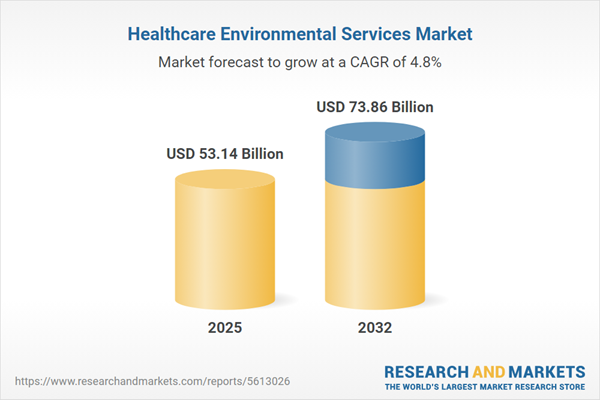Speak directly to the analyst to clarify any post sales queries you may have.
The healthcare environmental services market is evolving rapidly, shaped by regulatory pressures, technology adoption, and a demand for safer, cleaner care environments. As hospital executives and operations leaders aim to drive compliance, efficiency, and patient outcomes, this sector is a central component of healthcare delivery strategies.
Market Snapshot: Healthcare Environmental Services Market Performance and Growth
The Healthcare Environmental Services Market grew from USD 50.85 billion in 2024 to USD 53.14 billion in 2025. It is expected to continue growing at a CAGR of 4.77%, reaching USD 73.86 billion by 2032. This robust expansion highlights the sector’s rising importance for infection control, sustainability, and operational resilience across the global healthcare industry. Facilities are prioritizing specialized cleaning, waste management, and disinfection capabilities in response to stricter standards and elevated patient expectations.
Scope & Segmentation
The market’s comprehensive landscape covers a wide set of service types, facility formats, and organizational needs. The report analyzes trends and forecasts performance across the following key dimensions:
- Service Type: Cleaning & disinfection, linen & laundry, pest control, staff training & consultancy, waste management
- Service Form: On-demand, scheduled services
- Facility Type: Ambulatory surgical centers, clinics & physician offices, hospitals, laboratories & research facilities, long-term care facilities
- Organization Size: Large healthcare facilities, mid-size hospitals & clinics, small community health centers
- Regions:
- Americas: United States, Canada, Mexico, Brazil, Argentina, Chile, Colombia, Peru
- Europe, Middle East & Africa: United Kingdom, Germany, France, Russia, Italy, Spain, Netherlands, Sweden, Poland, Switzerland, UAE, Saudi Arabia, Qatar, Turkey, Israel, South Africa, Nigeria, Egypt, Kenya
- Asia-Pacific: China, India, Japan, Australia, South Korea, Indonesia, Thailand, Malaysia, Singapore, Taiwan
- Industry Leaders Assessed: ABM Industries Incorporated, American Bio Recovery Inc., Aramark Corporation, Cardinal Health Inc., Cintas Corporation, Clean Harbors Inc., Coverall North America Inc., Diversey Inc., Ecolab Inc., Enviro-Master Inc., ISS Facility Services Inc., Jani-King International Inc., McKesson Corporation, Medline Industries Inc., Sodexo Inc., Stericycle Inc., Sterigenics International LLC, Veolia Environnement S.A., Waste Management Inc.
Key Takeaways for Senior Decision-Makers
- Regulatory evolution and infection control protocols are reshaping service standards and procurement strategies, prompting a shift toward integrated, performance-focused partnerships.
- Technology advancements—such as advanced robotics, digital quality assurance, and real-time analytics—are improving service consistency while supporting budget and compliance objectives.
- Workforce upskilling, targeted training, and competency-based certification are responding to labor shortages and maintaining high standards of safety and operational excellence.
- Adoption of sustainable practices, including green chemistries and waste minimization, is enabling providers to meet client and regulatory requirements for environmental impact reduction.
- Boutique specialist firms and global multinationals alike are leveraging partnerships, acquisitions, and innovation hubs to address specific risk profiles and expand geographic reach.
- Market segmentation by service type, form, facility, and scale provides clear frameworks for vendors and buyers to match solutions to specific healthcare delivery needs.
Tariff Impact: Navigating Trade Policy for Resilient Healthcare Environmental Services
Recent trade policy changes in the United States, including tariff adjustments, have heightened cost pressures and introduced volatility in procurement of disinfectants, protective equipment, and specialized cleaning technologies. Providers are responding by strengthening domestic supplier relationships, exploring local manufacturing options, and adapting procurement strategies. These actions support service continuity and margin protection while maintaining high standards of care.
Healthcare Environmental Services Market: Methodology & Data Sources
Research combines structured executive interviews, primary facility-level surveys, and comprehensive reviews of industry publications, regulatory filings, and peer-reviewed literature. Quantitative and qualitative approaches ensure cross-validated, actionable insights aligned with actual market behavior and future trends.
Why This Report Matters to Industry Leaders
- Enables data-driven investment, procurement, and partnership decisions in a complex regulatory environment.
- Supports C-suite planning by benchmarking market readiness for new technologies, sustainability priorities, and evolving service delivery models.
- Fosters long-term competitive advantage through segmentation insights, provider benchmarking, and regional risk assessment.
Conclusion
Healthcare environmental services are central to operational efficiency and patient safety in modern care settings. Informed strategy and resilient partnerships will be key to delivering effective, sustainable outcomes as the sector adapts to new challenges and opportunities.
Additional Product Information:
- Purchase of this report includes 1 year online access with quarterly updates.
- This report can be updated on request. Please contact our Customer Experience team using the Ask a Question widget on our website.
Table of Contents
3. Executive Summary
4. Market Overview
7. Cumulative Impact of Artificial Intelligence 2025
Companies Mentioned
The companies profiled in this Healthcare Environmental Services market report include:- ABM Industries Incorporated
- American Bio Recovery, Inc.
- Aramark Corporation
- Cardinal Health, Inc.
- Cintas Corporation
- Clean Harbors, Inc.
- Coverall North America, Inc.
- Diversey, Inc.
- Ecolab Inc.
- Enviro-Master, Inc.
- ISS Facility Services, Inc.
- Jani-King International, Inc.
- McKesson Corporation
- Medline Industries, Inc.
- Sodexo, Inc.
- Stericycle, Inc.
- Sterigenics International, LLC
- Veolia Environnement S.A.
- Waste Management, Inc.
Table Information
| Report Attribute | Details |
|---|---|
| No. of Pages | 193 |
| Published | November 2025 |
| Forecast Period | 2025 - 2032 |
| Estimated Market Value ( USD | $ 53.14 Billion |
| Forecasted Market Value ( USD | $ 73.86 Billion |
| Compound Annual Growth Rate | 4.7% |
| Regions Covered | Global |
| No. of Companies Mentioned | 20 |






![Healthcare Quality Management (QMS) Market by Offering [Software (Integrated), Service], Function (Compliance, Risk, Audit, CAPA, Change), Use Case (Quality, Analytics, Performance, Regulatory), End User (Hospital, ASC, Payer) - Global Forecast to 2030 - Product Image](http://www.researchandmarkets.com/product_images/12859/12859907_60px_jpg/healthcare_quality_management_market.jpg)


